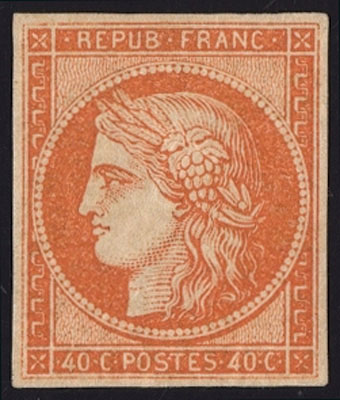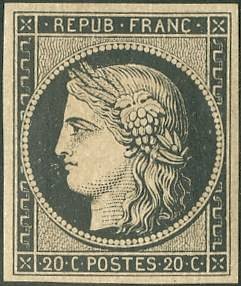|
Postage Stamps And Postal History Of France
This is a survey of the postage stamps and postal history of France. First stamps Second Republic The first stamps of France were issued on 1 January 1849. Retrieved 23 September 2010 They were designed by Jacques-Jean Barre. The medallion depicts the head of goddess Ceres facing left. In 1852 a new series of definitive stamps were issued, retaining the inscription "REPUB FRANC" but replacing Ceres with the head of Louis-Napoléon Bonaparte. Second Empire In 1853, after proclamation of the 2nd Empire, the inscription was changed to "EMPIRE FRANC", while retaining the head of Napoleon III in the medallion. Starting in 1862, a new type of definitive stamp was introduced. It depicts the head of Napoleon III with a laurel wreath and the inscription changed to "EMPIRE-FRANÇAIS". The Napoleon stamps remained in use until the fall of the 2nd Empire in 1870. Third Republic The Ceres series stamps, in a slightly different design and printed in lithography, were reintroduced in 18 ... [...More Info...] [...Related Items...] OR: [Wikipedia] [Google] [Baidu] |
Postage Stamp
A postage stamp is a small piece of paper issued by a post office, postal administration, or other authorized vendors to customers who pay postage (the cost involved in moving, insuring, or registering mail), who then affix the stamp to the face or address-side of any item of mail—an envelope or other postal cover (e.g., packet, box, mailing cylinder)—that they wish to send. The item is then processed by the postal system, where a postmark or cancellation mark—in modern usage indicating date and point of origin of mailing—is applied to the stamp and its left and right sides to prevent its reuse. The item is then delivered to its addressee. Always featuring the name of the issuing nation (with the exception of the United Kingdom), a denomination of its value, and often an illustration of persons, events, institutions, or natural realities that symbolize the nation's traditions and values, every stamp is printed on a piece of usually rectangular, but sometimes triangular ... [...More Info...] [...Related Items...] OR: [Wikipedia] [Google] [Baidu] |
Postal History
Postal history is the study of postal systems and how they operate and, or, the study of the use of postage stamps and covers and associated postal artifacts illustrating historical episodes in the development of postal systems. The term is attributed to Robson Lowe, a professional philatelist, stamp dealer and stamp auctioneer, who made the first organised study of the subject in the 1930s and described philatelists as ''"students of science"'', but postal historians as ''"students of humanity"''. More precisely, philatelists describe postal history as the study of rates, routes, markings, and means (of transport). A collecting speciality Postal history has become a philatelic collecting speciality in its own right. Whereas traditional philately is concerned with the study of the stamps ''per se'', including the technical aspects of stamp production and distribution, philatelic postal history refers to stamps as historical documents; similarly re postmarks, postcards, envel ... [...More Info...] [...Related Items...] OR: [Wikipedia] [Google] [Baidu] |
France
France (), officially the French Republic ( ), is a country primarily located in Western Europe. It also comprises of overseas regions and territories in the Americas and the Atlantic, Pacific and Indian Oceans. Its metropolitan area extends from the Rhine to the Atlantic Ocean and from the Mediterranean Sea to the English Channel and the North Sea; overseas territories include French Guiana in South America, Saint Pierre and Miquelon in the North Atlantic, the French West Indies, and many islands in Oceania and the Indian Ocean. Due to its several coastal territories, France has the largest exclusive economic zone in the world. France borders Belgium, Luxembourg, Germany, Switzerland, Monaco, Italy, Andorra, and Spain in continental Europe, as well as the Netherlands, Suriname, and Brazil in the Americas via its overseas territories in French Guiana and Saint Martin. Its eighteen integral regions (five of which are overseas) span a combined area of and contain clos ... [...More Info...] [...Related Items...] OR: [Wikipedia] [Google] [Baidu] |
Jacques-Jean Barre
Jacques-Jean Barre (3 August 1793 in Paris-10 June 1855 in Paris) was the general engraver at the Monnaie de Paris between 1842 and 1855. In this position, he engraved and designed French medals, the Great Seal of France, bank notes and postage stamps, as well as the first Swiss coinage which was initially minted there. His name is ''Jacques-Jean Barre'' but is often incorrectly labelled as 'Jean-Jacques', as it is the more common use of the name. From the late 1840s until 1855, he created the first two French postage stamp designs: the Ceres series and Napoleon III series. His two sons, artists themselves, succeeded him at the post of general engraver: * Albert Désiré Barre * and Jean-Auguste Barre Jean Auguste Barre (25 September 1811 – 5 February 1896) was a French sculptor and medalist. Born in Paris, he was trained by his father Jean-Jacques Barre (1793–1855), a medalist. Barre studied at the École nationale supérieure des Be ... (only during one year). ... [...More Info...] [...Related Items...] OR: [Wikipedia] [Google] [Baidu] |
Napoleon III
Napoleon III (Charles Louis Napoléon Bonaparte; 20 April 18089 January 1873) was the first President of France (as Louis-Napoléon Bonaparte) from 1848 to 1852 and the last monarch of France as Emperor of the French from 1852 to 1870. A nephew of Napoleon I, he was the last monarch to rule over France. Elected to the presidency of the Second Republic in 1848, he seized power by force in 1851, when he could not constitutionally be reelected; he later proclaimed himself Emperor of the French. He founded the Second Empire, reigning until the defeat of the French Army and his capture by Prussia and its allies at the Battle of Sedan in 1870. Napoleon III was a popular monarch who oversaw the modernization of the French economy and filled Paris with new boulevards and parks. He expanded the French overseas empire, made the French merchant navy the second largest in the world, and engaged in the Second Italian War of Independence as well as the disastrous Franco-Prussian War, dur ... [...More Info...] [...Related Items...] OR: [Wikipedia] [Google] [Baidu] |
Jules Auguste Sage
Jules Auguste Sage (Paris, 16 March 1829 - Paris, 13 October 1908) was a French poet, artist and sculptor. He is known for giving his name to a type of French postage stamp, Type Sage, first issued in 1876. Life Sage exhibited at the Paris Salons between 1870 and 1901 and became a member of the Société des artistes français in 1883. Stamps He designed the Type Sage postage stamps, also referred as the ''Peace and Commerce'' issue that the postal administration selected in a competition. The engraving was made by Louis-Eugène Mouchon. These stamps were a replacement for both the Ceres series that had lasted from 1849 to 1851 in different forms, and the Napoleon III Napoleon III (Charles Louis Napoléon Bonaparte; 20 April 18089 January 1873) was the first President of France (as Louis-Napoléon Bonaparte) from 1848 to 1852 and the last monarch of France as Emperor of the French from 1852 to 1870. A neph ... stamps. The Type Sage were in use 1876 until 1900 and wer ... [...More Info...] [...Related Items...] OR: [Wikipedia] [Google] [Baidu] |
Ceres Series (France)
The Ceres series was the first postage stamp series of France, issued in 6 different values from 1849 to 1850 as a representation of the French Republic. The series bore the effigy of Ceres, goddess of growing plants in Roman mythology. Jacques-Jean Barre did the initial drawing and gravure. Anatole Hulot was in charge of the printing of the Ceres series done in Paris in the 19th century. The drawing was used again by necessity when the Second Empire fell in 1870, with printing in Paris besieged by German armies and in Bordeaux where the French government fled. Two new Ceres series were issued in the 1930s and 1940s. As first series of France, these stamps appeared regularly on commemorative stamps for philatelic anniversaries and exhibitions, and on the logo of many philatelic organizations and firms. Stamps of France Second Republic, 1849-1851 The two first postal stamps issued in France were of the Ceres series. They were printed with the effigy of Ceres, goddess ... [...More Info...] [...Related Items...] OR: [Wikipedia] [Google] [Baidu] |
French Post Offices Abroad
The French post offices abroad were a global network of post offices in foreign countries established by France to provide mail service where the local services were deemed unsafe or unreliable. They were generally set up in cities with some sort of French commercial interest. They started appearing in the early 19th century, reached their heyday at the beginning of the 20th century, then started closing down in the 1910s and 1920s, with the office at Kwangchou in China holding out until the 1940s. Offices abroad: * French post offices in China * French post offices in Crete * French post offices in Egypt The French post offices in Egypt were a system of post offices maintained by France in Egypt during the 19th century and the early years of the 20th century. They were primarily intended to facilitate commercial and trading interests that needed t ... * French post offices in the Ottoman Empire * French post offices in Zanzibar Sources * Stanley Gibbons Ltd: various cat ... [...More Info...] [...Related Items...] OR: [Wikipedia] [Google] [Baidu] |
Type Sage
"Type Sage" (also referred to as "Peace and Commerce") is a reference to the definitive series of postage stamps issued by the post office of France between 1876 and 1900. Printed in a variety of colors and shades, the two central figures are allegories of Peace (left) and Commerce (right), giving rise to the name of the series. The name "Type Sage" comes from the tendency of French stamp collectors to refer to the series by the name of the designer of the artwork, in this case Jules Auguste Sage, whose name appears as "J. A. SAGE INV" along the lower left edge of the stamp beneath the word "REPUBLIQUE" of "REPUBLIQUE FRANCAISE." The Type Sage / Peace and Commerce series is one of the more extensive definitive series from the late 19th century. The Scott Catalogue notes forty-four (44) different stamps in this series, ranging in face value from 1 centime to 5 francs, not counting overprints and minor varieties. Stamps of this design issued with perforations were used in Fra ... [...More Info...] [...Related Items...] OR: [Wikipedia] [Google] [Baidu] |
Navigation And Commerce Issue
The Navigation and Commerce issue is a series of key type stamps issued for the colonial territories of France. It was designed by Louis-Eugène Mouchon. The issue uses a standard design featuring allegorical representations of navigation and commerce. The territory name is imprinted in a rectangular cartouche centered at the bottom of the stamp. In French colonies, it is the first series of territory-specific postal releases. Adding the territory name helped reduce revenue loss incurred when stamps were purchased in colonies with low-value currencies, then sold or used in colonies with high-valued currencies. It was first released in 1892, with later releases featuring new color schemes. Dates vary by territory, but by 1900 values start appearing surcharged in red or black ink to use the remaining stocks while colonies then used illustrated stamps. List of French territories that used Navigation and Commerce stamps File:Stamp Anjouan 1892 1c.jpg, Anjouan File:Stamp Beni ... [...More Info...] [...Related Items...] OR: [Wikipedia] [Google] [Baidu] |







